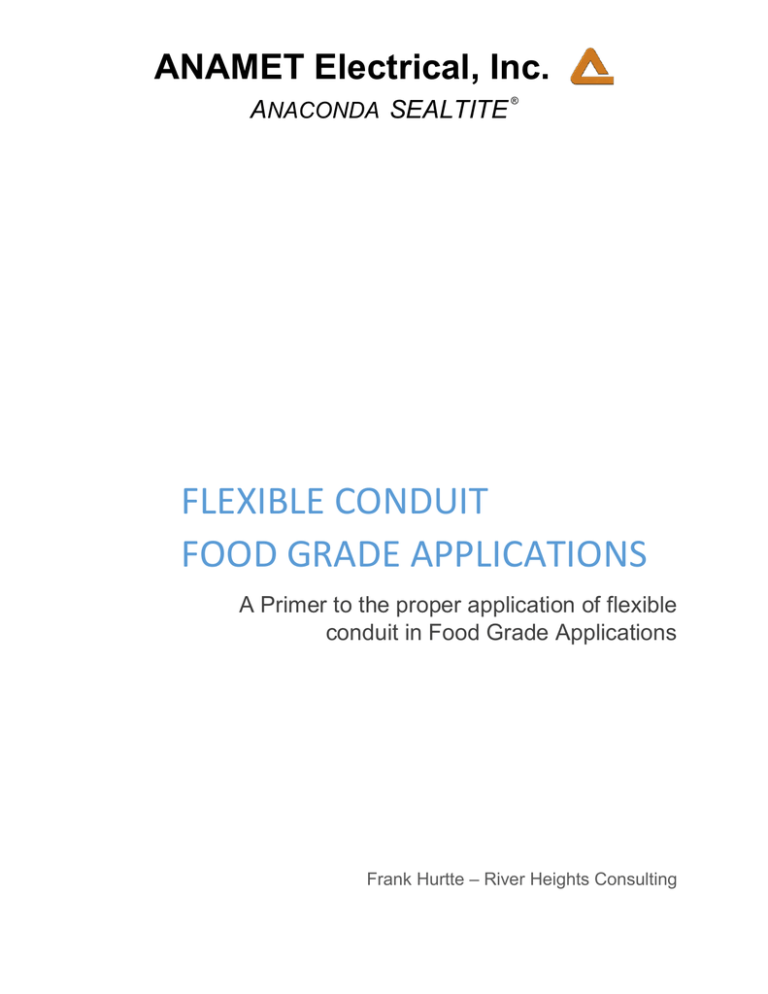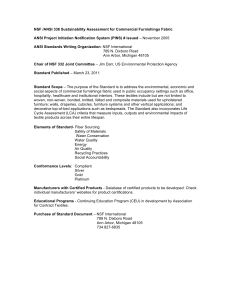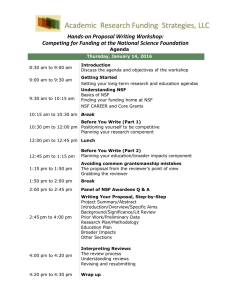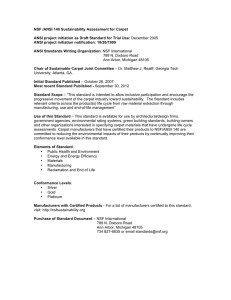Food Grade White Paper - ANAMET Electrical, Inc.
advertisement

ANAMET Electrical, Inc. ANACONDA SEALTITE ® FLEXIBLE CONDUIT FOOD GRADE APPLICATIONS A Primer to the proper application of flexible conduit in Food Grade Applications Frank Hurtte – River Heights Consulting Introduction Food Production Daily reports, product recalls and food borne illness in the United States have reached an estimated $77 Billion annual cost. Based on information provided by the Federal Center for Disease Control, the top five food-based contaminants alone account for over 1,100 deaths per year. Food Safety is important to consumers and critically important to those engaged in the food industry. Out breaks of deadly bacteria like Listeria, E.coli, Salmonella and a list of thirty-some others make the National News on a regular basis. Food product recalls are common and expensive. Litigation and fines based on food contamination can easily reach into the millions of dollars. But the real pain comes in the form of damage to a company’s reputation in the marketplace. Once your company’s name is associated with even a small food contamination incident, major groceriers, food suppliers and big box chains avoid carrying your products. In some instances, legions of consumers switch their buying habits. Use of the proper equipment throughout food processing and preparation is a critical cog in maintaining a safe food supply. Food safety professionals agree small oversights can lead to big issues downstream. Overlooking just one piece of equipment might create an environment perfect for the incubation and spread of harmful bacteria. This document highlights the importance of understanding food grade requirements in the application of flexible conduit for connecting the electrical feed to equipment in food preparation facilities. The difference between Watertight and Food Grade The most common mistake made by untrained/uninformed workers comes via the assumption a water-tight rating provides the proper protection in a wash-down centric food environment. Electrically speaking, selecting IP66-67 flexible conduit with the appropriate fittings provides protection against pressure sprays, but in a food preparation/processing area, this is not enough. First, the materials used in close proximity to food materials must be free of chemicals known to be harmful in the food supply. For example, some plastic formulas used in the manufacture of electrical products are unsafe around food. Cords, enclosures, fittings and flexible conduit used in proximity to food must meet standards laid down by government and regulatory entities. For instance, PVC’s and other plastics are regulated by the Food and Drug Administration (FDA) and governed by FDA CFR-21 regulations. In addition, food grade materials are defined and certified by regulations laid down by the governmentally aligned NSF in document NSF/ANSI – 51. While we are on the subject of the difference between watertight and Food Grade products, let’s talk about fittings. Many metallic fittings designed for standard water tight applications are made of malleable iron/steel materials which are then zinc plated or dipped (galvanized) for corrosion resistance. This is not good. NSF/ANSI – 51 clearly states, “Zinc coatings shall not be used in a food zone.” Grabbing a handful of the wrong metallic fittings and heading out to make a quick repair can be hazardous to somebody’s health. What is the NSF and where do they fit into the Food Grade equation? The NSF was founded as the National Sanitation Foundation in the University of Michigan’s School of Public Health back in 1944. Today, the organization is headquartered in Ann Arbor, Michigan and maintains offices and labs in 28 countries. The group is a World Health Organization Collaboration Center for food and water safety. They work closely with government agencies including the Food and Drug Administration, the Department of Agriculture and many others. The standards and testing criteria defined by NSF are co-listed by the American National Standards Institute (ANSI). NSF does ongoing work to establish minimum food protection and sanitation requirements for the materials, design, construction and performance of food handling and processing equipment. For the purposes of our discussion, we need to focus on two very important NSF/ANSI standards impacting the flexible conduit products. NSF/ANSI 51: Food Equipment Materials – this standard established minimum public health and sanitation requirements for materials and finishes used in the manufacturer of commercial foodservice equipment (such as broilers, beverage dispensers, cutting boards and stock pots) and its components (such as tubing, sealants, gaskets and flexible conduit). If a device is not made of materials allowed in NSF/ANSI 51, they are not part of a legally based food system. NSF/ANSI 169: Special Purpose Food Equipment and Devices – this standard establishes minimum food protection and sanitation requirements for the materials, design, fabrication, construction and performance of special purpose food handling and processing equipment not covered by individual standards. The NSF/ANSI 169 standard goes well beyond material content extending into design criteria. For instance, NSF/ANSI 169 stipulates designs be free of dead areas and crevices which allow for food buildup and germ growth. Sharp corners on equipment are known to create spots which is difficult to thoroughly clean and are capable of acting as a harbinger of bacteria action. Fasteners, surface finish, lip areas and other mechanical design features are also spelled out in detail. It should be noted, NSF provides a list of manufacturers/products certified for use in NSF/ANSI 169 Food Service applications. Regardless of outward appearance and supplier claims, failure to properly use a certified product can lead to potential issues. NSF also defines areas called food zones. Understanding their meaning is of critical importance to your application. Author note: Graphic from foodsafetymagazine Feb/March 2003 Understanding Food Zones NSF defines four zones pertinent to our work. In laymen’s terms these are defined as follows: The Food Zone – Area where direct contact with food products is normally expected and surfaces from which the food may drip, drain or splash back onto surfaces normally in contact with foods. The Splash Zone – Areas where direct contact with food products during normal operations would not be expected, however equipment in this area may be situated such that liquids used in the process, cleaning or both may splash, spill or otherwise soil the surfaces. Once splashed there is a chance that liquids might drip down onto surfaces which normally contact with foods. The Non-Food Zone – Areas where no contact with food is expected. These areas are not subject to the typical wash down procedures. In this area care must be taken to insure that physical deterioration of materials does not occur which could lead to migration into food contact areas. The Unexposed Non-Food Zone – Areas which are within the same facility but separated from the Food and Splash Zones by walls or other physical barriers. It must be noted; these zones apply to any areas where food is prepared or processed. Restaurants, packing plants and institutional kitchens are impacted similarly. Further, experts in the field are calling for expansion of the Splash Zone to include area which have traditionally been thought of as non-food zones. For instance, many restaurants now consider visitor waiting areas as part of the Splash Zone because food particles are finding their way into the area and soiling the environment. What differentiates Anamet Food Grade products from competition? Anamet Food Grade products meet all the requirements of the most stringent category for Food Zone applications. They are approved for installation within the Food Zone. They are listed as non-contact because they are not intended to be used as a surface for food preparation; however the material is approved for food contact. This means they can be installed in the Food Zone area where contact may occur. Most of the competition only meets the Non-Food Zone or Splash Zone categories. These products are not approved for incidental contact with food. It is extremely important that those responsible for product specification select the correct product for the application. Selecting the right product for your application The most important point of the whole Food Grade discussion comes via the selection of the proper product for your specific application. Determine the Zone Minimum Requirement Questions 1. Is food present or sometimes present in the location? 2. Is there a possibility that food or the juices created by the food process could soil some part of the equipment or adjacent environment? 3. Is there a potential for food-based particles to splash onto the equipment during a portion of the cleaning process? If the answer to any of these questions is yes, your application falls into either the Food or Splash Zone and requires Food Grade Equipment. Optional - Extra Food Safety Questions 1. Do food particles or other opportunities for soiling find themselves into this environment? 2. Is there a potential for common cleaning practices to cross contaminate other Food Zones? If the answer to either of these questions is yes, many food safety Food or Splash Zone Selecting experts would recommend you consider them as Splash Zone applications. Food Grade equipment which also meets the environmental specifications for the application is required. Food Grade standards must be laid over the top of normal standards such as IP rating and temperature ranges. Equipment used must meet these guidelines Materials used in the construction meet FDA CFR 21 and NSF 51 requirements. This includes all PVC’s, plastics and other materials. Materials are NSF Certified to NSF/ANSI 169 standards. (When in doubt, certified manufacturers are listed at: http://info.nsf.org/certified/food Whenever possible use products which were designed to be matched. In the case of flexible conduit, insure the fittings are both designed for food and beverage locations and properly matched with the conduit. Remember: if fittings used some kind of galvanized or zinc plating, they are implicitly forbidden. If you are working in these industries, extra attention should be paid to meeting food safety standards. Industries with Food Grade Requirements Food Machinery OEMs and Installers Including the following: Beverage Equipment Coaters Coolers Dairy Equipment Dish Washers Fillers Hot Bars Mixers and Blenders Cold Bars Extruders Homogenizers Packaging Equipment Restaurants and Restaurant Equipment Installers Meat and Poultry Packing and Processing Facilities Dairies, Creameries and Cheese Processing Facilities Beverage Bottling Facilities Canning Plants Pharmaceutical Facilities Animal Food Products A final word on Food Safety A little bit of food contamination can create mega health and safety issues. In 2014, one incident with peanut and almond butter impacted a dozen retailers and created a recall which spread across the United States, Canada, Hong Kong, United Arab Emirates and Dominican Republic. And, while only a handful of people developed any form of illness, the immediate economic impact certainly swelled into the millions of dollars. Consumer confidence and the retailer shelf space losses were most likely far more damaging. Failing to take the proper precautions does not make good business sense. Let the makers of Anaconda SEALTITE help Anaconda SEALTITE is available as an NSF Certified Component in both a metallic and nonmetallic form factor. This meets FDA CFR 21 and NSF 51 requirements and carries NSF/ANSI 169 Certifications. The product is designed to provide IP 66/67 rated protection throughout extremes in temperature (-4 to +140 degrees F). When combined with Anaconda Fittings, these products provide food grade ratings in all of the common industry sizes from 3/8 to 2 inch sizes. Aside from meeting all of these important specifications, Anaconda exceeds the food service ratings by providing a specially formulated PVC coating which is both easily cleaned and designed not to promote bacteria growth. About Anamet Electrical Inc. the makers of Anaconda SEALTITE Anamet Electrical Inc., is the global leader in offering the highest quality products, superior service and pioneering innovations for flexible liquid-tight electrical wiring conduit and industrial stainless steel stripwound hose markets. Our Anaconda - SEALTITE® brand name is recognized and respected worldwide by customers in multiple markets including electrical distribution, residential commercial and industrial construction, MRO-industrial maintenance and repair, OEMs, government, military shielding, power generation, mass transit, utility, petrochemical, food processing, nuclear power plants and chemical processing. Anamet's Anaconda - SEALTITE® is recognized for quality innovation, the innovation and quality which competition follows. For more than 100 years, we have utilized our proprietary machinery and process technology to enhance and expand our product lines while effectively meeting our customers' increasing needs for actual enhanced flexible conduit performance. Our focused solutions emphasize quality and superior performance for our many globally recognized customers. Delivering the most advanced and strategic solutions for today's demanding marketplace continues to be the driving force behind our expanding product lines. We have earned a reputation for the broadest engineered and the highest quality offering in the flexible liquid-tight electrical wiring conduit market. Our commitment to excellence and dedication to customer satisfaction acts as our vision for the future. Headquartered in Mattoon, Illinois - Anamet respectfully acknowledges our global customer base in making us the world's largest manufacturer and supplier of flexible conduit. Disclaimer The information contained in this white paper is intended for use as a guide by persons who have technical skill at their discretion. Anamet Electrical Inc. disclaims any liability from any information contained or absent from this document. ANAMET Electrical Inc., 1000 Broadway Ave East Mattoon, IL. 61938 Ph. 800-230-3718 Fax. 800-677-2706 www.anacondasealtite.com


